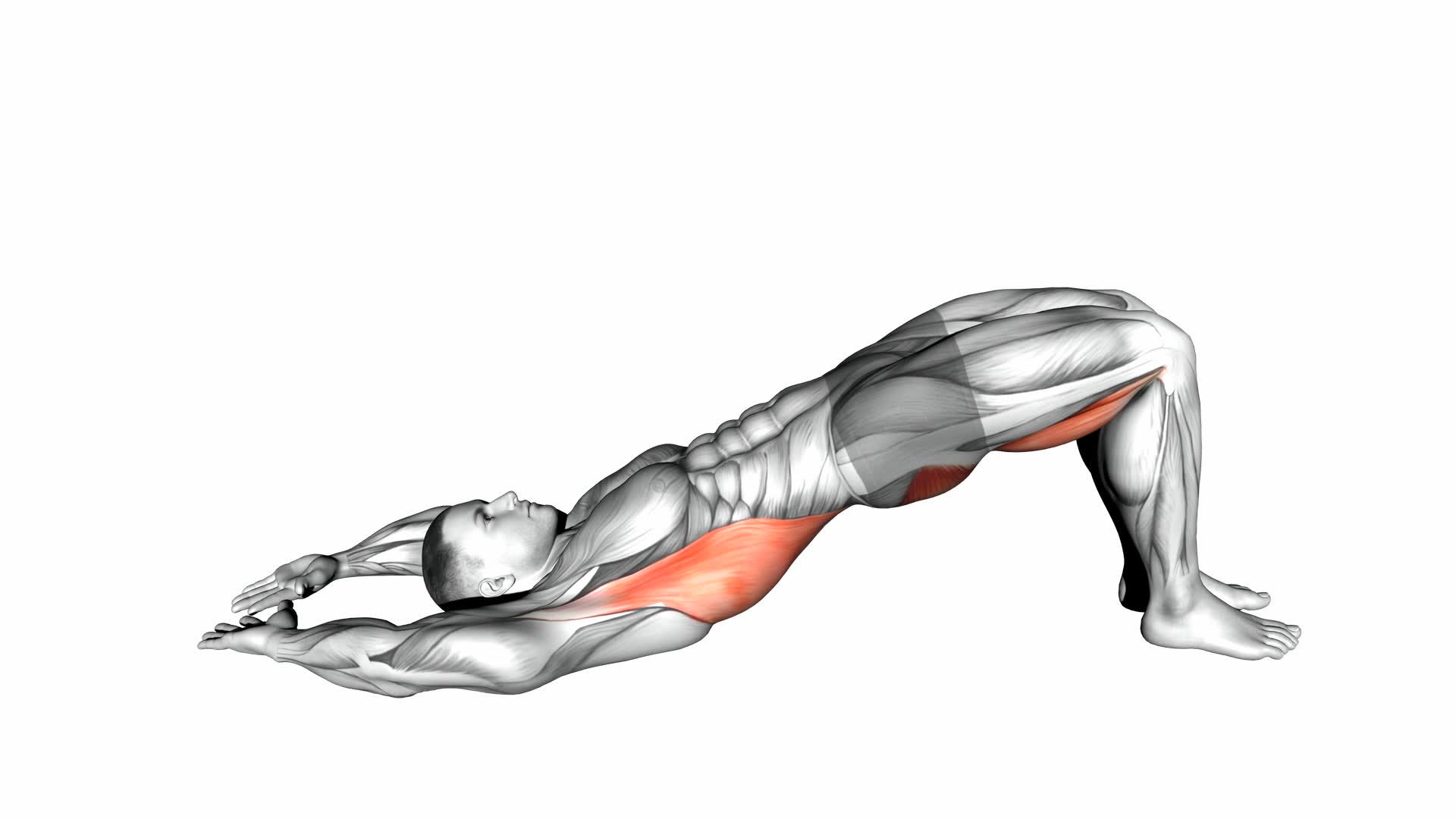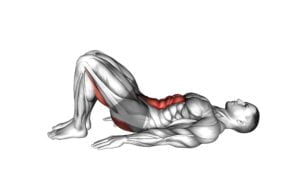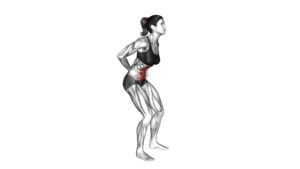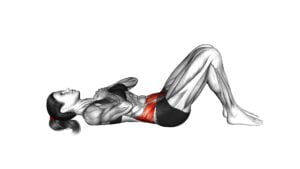Pelvic Tilt Into Bridge – Video Exercise Guide & Tips

Get ready to improve your core strength and flexibility with the Pelvic Tilt Into Bridge exercise!
Watch This Exercise Video
In this video exercise guide, you'll learn the proper technique, common mistakes to avoid, and variations to challenge yourself.
With helpful tips and modifications for different fitness levels, you can make the most out of this exercise.
So grab your mat, hit play, and get ready to feel the burn!
Key Takeaways
- The pelvic tilt into bridge exercise strengthens and tones core muscles.
- It improves posture, stability, and flexibility in the hips and spine.
- The exercise targets muscles in the abdomen, lower back, and glutes.
- Engaging the core muscles, especially the transverse abdominis, is crucial for proper execution of the exercise.
Benefits of the Pelvic Tilt Into Bridge Exercise
One major benefit of the Pelvic Tilt Into Bridge exercise is that it strengthens and tones your core muscles.
To ensure a safe and effective workout, it's important to start with a proper warm up. This can include light cardio exercises such as jogging or jumping jacks to increase blood flow and prepare your muscles for the upcoming workout.
In terms of equipment, the Pelvic Tilt Into Bridge exercise can be done without any specific equipment. However, if you prefer to add resistance, you can use a yoga mat for comfort and stability.
By engaging your core muscles, the Pelvic Tilt Into Bridge exercise helps to improve your posture and stability. It targets the muscles in your abdomen, lower back, and glutes, making them stronger and more defined. Additionally, this exercise can help to relieve lower back pain and improve flexibility in the hips and spine.
In the next section, we'll discuss the proper technique for the Pelvic Tilt Into Bridge exercise to ensure maximum effectiveness and safety.
Proper Technique for the Pelvic Tilt Into Bridge
To perform the Pelvic Tilt Into Bridge exercise correctly, follow these steps:
- Lie on your back with your knees bent and feet flat on the floor.
- Engage your core by drawing your belly button in towards your spine.
- Slowly lift your hips off the ground, pushing through your feet and squeezing your glutes.
- Maintain a straight line from your shoulders to your knees.
- Focus on tilting your pelvis upward, tucking your tailbone under and pressing your lower back into the floor.
- Hold the pelvic tilt for a few seconds.
- Release and lower your hips back down to the starting position.
Performing the Pelvic Tilt Into Bridge exercise with proper technique can improve core strength, stability, and flexibility. If you have any concerns or limitations, consult with a qualified fitness professional or modify the exercise to suit your needs.
Now that you know how to perform the Pelvic Tilt Into Bridge correctly, let's move on to the next section about common mistakes to avoid.
Common Mistakes to Avoid
To ensure proper hip alignment, avoid letting your hips sag or lift too high during the pelvic tilt into bridge exercise.
Engage your core muscles throughout the movement to maintain stability and control.
Proper Hip Alignment
Align your hips properly to avoid common mistakes while performing the pelvic tilt into bridge exercise. Proper hip alignment is crucial for maintaining hip flexibility and pelvic stability. Here are some common mistakes to avoid:
- Avoid excessive arching of the lower back: When performing the pelvic tilt into bridge, focus on engaging your core muscles and maintaining a neutral spine. Excessive arching can put unnecessary strain on the lower back.
- Keep your knees in line with your hips: As you lift your hips into the bridge position, make sure your knees stay aligned with your hips. This helps ensure proper alignment and prevents any unnecessary stress on the knees.
- Engage your glutes: To achieve proper hip alignment, it's important to activate your glute muscles. Squeeze your glutes as you lift your hips into the bridge position, which helps to stabilize the pelvis.
- Maintain equal weight distribution: Avoid shifting your weight to one side while performing the exercise. Distribute your weight evenly between both feet to maintain proper hip alignment and prevent any imbalances.
Engaging Core Muscles
Avoiding common mistakes is crucial when engaging your core muscles during the pelvic tilt into bridge exercise. Properly engaging the deep muscles of your core is essential for maximizing the benefits of this exercise and preventing injury.
To ensure effective core activation, focus on engaging the transverse abdominis, which is the deepest layer of your abdominal muscles. This can be done by drawing your belly button towards your spine and maintaining this contraction throughout the exercise.
Additionally, incorporating core activation techniques such as breathing deeply into your diaphragm and maintaining a neutral spine position can further enhance the engagement of your core muscles.
Variations to Increase the Difficulty
You can progress the pelvic tilt into bridge exercise by incorporating challenging variations. Here are four ways you can increase the difficulty and take your workout to the next level:
- Advanced Modifications: Once you have mastered the basic pelvic tilt into bridge, you can try advanced modifications such as elevating your feet on a stability ball or using a resistance band around your thighs to add extra resistance.
- Equipment Variations: If you have access to gym equipment, you can use a barbell or dumbbells to add weight to the exercise. Simply hold the weights on your hips as you perform the pelvic tilt into bridge, increasing the resistance and intensifying the workout.
- Single-Leg Bridge: To further challenge your core and lower body strength, try performing the pelvic tilt into bridge with one leg raised off the ground. This variation requires additional stability and engages the muscles in a different way.
- Swiss Ball Bridge: Using a stability ball, place your feet on top and lift your hips into a bridge position. This variation adds an element of instability, forcing your core and glutes to work harder to maintain balance.
By incorporating these variations, you can continue to challenge yourself and make progress in your pelvic tilt into bridge exercise.
Now, let's move on to the next section and explore some tips for getting the most out of this exercise.
Tips for Getting the Most Out of the Exercise
To get the most out of the pelvic tilt into bridge exercise, it's important to focus on proper form techniques. Keep your core engaged and make sure your back stays straight throughout the movement.
Additionally, remember to breathe and relax, allowing your body to fully benefit from the exercise.
As you progress, consider modifying the exercise to increase the difficulty and continue challenging your muscles.
Proper Form Techniques
Maximize your results with these form techniques for the pelvic tilt into bridge exercise. Proper form is essential for getting the most out of this exercise and avoiding injury.
Here are four tips to help you maintain proper form:
- Align your body: Start by lying on your back with your knees bent and feet flat on the ground. Ensure that your feet are hip-width apart and aligned with your knees and hips.
- Engage your core: Before lifting your hips, engage your core muscles by drawing your belly button towards your spine. This will help stabilize your pelvis and protect your lower back.
- Control your movement: Slowly lift your hips off the ground, using your glutes and hamstrings. Avoid arching your back or pushing too hard with your feet.
- Maintain a neutral spine: Throughout the exercise, focus on keeping your spine in a neutral position. Avoid excessive rounding or overarching of your back.
Breathing and Relaxation
To get the most out of the pelvic tilt into bridge exercise, focus on maintaining a relaxed breathing pattern. Proper breathing techniques can enhance the effectiveness of this exercise and promote relaxation.
As you lift your hips off the ground and move into the bridge position, take a slow and deep breath in through your nose. As you lower your hips back down, exhale slowly through your mouth. This controlled breathing pattern helps to oxygenate your muscles and promote relaxation throughout your body.
Progression and Modifications
As you progress in your pelvic tilt into bridge exercise, you can modify the movement to challenge your muscles further and maximize your results. Here are some advanced modifications to take your exercise to the next level:
- Single-leg bridge: Lift one leg off the ground while performing the bridge to increase the intensity and engage your glutes and hamstrings even more.
- Stability ball bridge: Place a stability ball under your feet and perform the bridge to challenge your core stability and enhance the activation of your glutes and hamstrings.
- Weighted bridge: Hold a dumbbell or a weighted plate on your hips while performing the bridge to add resistance and increase the strength-building benefits.
- Bridge with marching: Lift one leg off the ground and hold it in the air while performing the bridge, then alternate legs in a marching motion to further engage your core and challenge your balance.
Precautions and Modifications for Different Fitness Levels
For individuals of varying fitness levels, modifications and precautions should be taken into account when performing the pelvic tilt into bridge exercise. It's important to remember that everyone's body is different, and what works for one person may not work for another. Before attempting this exercise, it's crucial to consult with a healthcare professional or fitness expert to ensure that it's safe for you.
For beginners or individuals with limited mobility, it may be helpful to start with modifications. One modification is to perform the exercise with bent knees instead of straight legs. This can help reduce strain on the lower back and make the movement more accessible. Additionally, using a yoga block or bolster under the pelvis can provide extra support and stability.
For those with more advanced fitness levels, there are precautions to keep in mind. It's important to engage the core muscles and maintain proper form throughout the exercise. Avoid overarching the lower back and focus on keeping the pelvis stable. Additionally, if you have any pre-existing conditions or injuries, it's essential to modify the exercise accordingly or avoid it altogether.
Frequently Asked Questions
Can the Pelvic Tilt Into Bridge Exercise Help Improve Posture?
The pelvic tilt into bridge exercise is a great way to improve your posture.
By engaging your core muscles, this exercise helps to strengthen and stabilize your spine, promoting better alignment and reducing slouching.
When performed with proper form and technique, the pelvic tilt into bridge targets the muscles in your lower back, glutes, and abdominals, which are important for maintaining good posture.
Regularly incorporating this exercise into your routine can lead to improved posture and overall spinal health.
How Often Should I Perform the Pelvic Tilt Into Bridge Exercise?
To maximize the benefits of the pelvic tilt into bridge exercise, it's important to know how often to perform it. The frequency of this exercise depends on your fitness level and goals.
Generally, it's recommended to incorporate it into your routine at least 2-3 times per week. However, for more noticeable improvements in posture and core strength, you may choose to perform it daily.
Can the Pelvic Tilt Into Bridge Exercise Help Alleviate Lower Back Pain?
The pelvic tilt into bridge exercise can be beneficial for alleviating lower back pain. By engaging your core and glute muscles, this exercise helps to strengthen and stabilize your lower back.
The technique involves tilting your pelvis upward while lifting your hips off the ground, forming a bridge shape with your body. This movement helps to improve flexibility, reduce tension in the lower back, and promote better posture.
Incorporating pelvic tilt into your exercise routine can provide relief and prevent future pain.
Is It Normal to Feel Some Discomfort in the Hips While Performing the Pelvic Tilt Into Bridge Exercise?
Feeling some discomfort in the hips during the pelvic tilt into bridge exercise isn't uncommon. It's important to remember that everyone's body is different, and what may be uncomfortable for one person mightn't be for another.
This discomfort could be due to various factors, such as tight hip muscles or improper pelvic alignment. It's always a good idea to consult with a healthcare professional or a qualified fitness instructor to ensure proper form and technique while performing this exercise.
Can the Pelvic Tilt Into Bridge Exercise Be Modified for Individuals With Limited Flexibility?
If you have limited flexibility, there are modified variations of the pelvic tilt into bridge exercise that can be beneficial. These variations can help you work within your range of motion and avoid discomfort.
By adjusting the position of your feet or using props like blocks or bolsters, you can customize the exercise to suit your needs.
It's important to listen to your body and find the variation that feels right for you.
Conclusion
Incorporating the pelvic tilt into bridge exercise into your fitness routine can offer a range of benefits, including improved core strength, flexibility, and posture. By following proper technique and avoiding common mistakes, you can maximize the effectiveness of this exercise.
For those looking for a challenge, there are variations available to increase difficulty. Remember to listen to your body, make necessary modifications, and consult with a fitness professional if needed.
Start incorporating this exercise today to enhance your overall fitness and well-being.

Author
Years ago, the spark of my life’s passion ignited in my mind the moment I stepped into the local gym for the first time. The inaugural bead of perspiration, the initial endeavor, the very first surge of endorphins, and a sense of pride that washed over me post-workout marked the beginning of my deep-seated interest in strength sports, fitness, and sports nutrition. This very curiosity blossomed rapidly into a profound fascination, propelling me to earn a Master’s degree in Physical Education from the Academy of Physical Education in Krakow, followed by a Sports Manager diploma from the Jagiellonian University. My journey of growth led me to gain more specialized qualifications, such as being a certified personal trainer with a focus on sports dietetics, a lifeguard, and an instructor for wellness and corrective gymnastics. Theoretical knowledge paired seamlessly with practical experience, reinforcing my belief that the transformation of individuals under my guidance was also a reflection of my personal growth. This belief holds true even today. Each day, I strive to push the boundaries and explore new realms. These realms gently elevate me to greater heights. The unique combination of passion for my field and the continuous quest for growth fuels my drive to break new ground.



